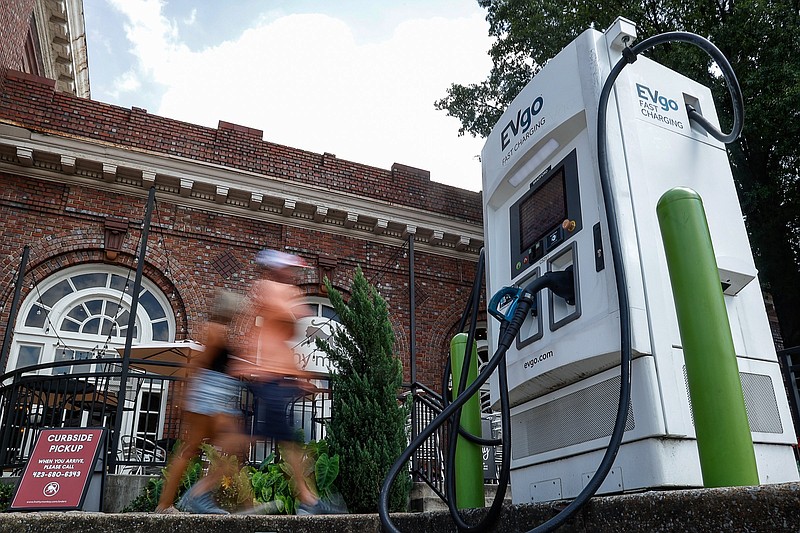You may have missed this bit of important news earlier this month - given all the necessary concern over COVID-19, Afghanistan, a local election and other breaking news. But here's an encouraging development: Combined, Tennessee auto plants will soon make the Volunteer State the biggest state in the Southeast - and No. 3 in the nation - for EV production. That's electric vehicle production.
Our bet is that we eventually will top that No. 3 ranking in the country.
Why? Because we in Chattanooga and Tennessee already have a rich history and a rich present in electric vehicles.
Our city was an early leader in testing battery-powered vehicles at the electric vehicle test facility TVA built in the late 1970s, and Chattanooga pioneered one of the first electric-powered downtown shuttle systems in the 1980s built in Chattanooga by Advanced Vehicle Systems. CARTA also started one of the state's first electric vehicle rideshare programs in 2016 to allow drivers to rent battery-powered Nissan Leafs (built in Smyrna, Tennessee,) by the hour.
Add to that, VW is investing $800 million to add a battery-powered small SUV to its lineup of cars made at its Chattanooga assembly plant. And up the road in Spring Hill, Tennessee, GM is spending $2 billion to begin making the Cadillac Lyriq.
This is encouraging on two fronts. First, our city and state economy. And second, our planet and its climate.
President Joe Biden's vision of a green future was made clear in his August executive order announcing stricter fuel-efficiency standards and calling for half of new cars to be electric or plug-in hybrids by 2030.
That's not pie in the sky. Already, sales of hybrid cars, which have gas engines but can run on electricity for a limited range, were and are surging - a good sign for the future of electric vehicles. Also Ford Motor Co., for the first time in its 118-year history, already had said it plans to spend more on electrified vehicles than it does on internal combustion engine vehicles starting in 2023.
But in typical naysayer fashion, critics are again wagging their tongues. Where are these electric vehicles going to plug in and fuel up? they chorus.
Short answer: All over the place. Especially at home. Imagine. A gas station in your garage, but it doesn't look or smell like a gas station. What a concept.
Still, the above-mentioned news story earlier this month stated: "But something really basic is standing in the way" of Biden's plan - "enough outlets to plug in all those cars and trucks."
(READ MORE: Ford plans biggest new manufacturing investment ever in Tennessee)
The story continued. "The country has tens of thousands of public charging stations - the electric car equivalent of gas pumps - with about 110,000 chargers. But energy and auto experts say that number needs to be at least five to 10 times as big to achieve the president's goal. Building that many will cost tens of billions of dollars, far more than the $7.5 billion lawmakers have set aside in the infrastructure bill."
Not to rain on the rain parade, but:
* Even in 2013, thanks to the Nissan Leaf, our first electric car built in Smyrna, Tennessee, the Chattanooga area alone boasted of nearly 40 charging stations downtown and at local tourist attractions.
Now, Tennessee has hundreds of low-voltage recharging stations, 24 high-voltage recharging stations standardized for all-electric vehicles and other high-voltage stations for particular models such as the Tesla. Chattanooga has one-third of the rapid charging stations due to early investments by EPB, CARTA and Tesla, along with tens of dozens of other slower public charging outlets in public parking lots, restaurants and local attractions, according to Chargehub.com.
* Volkswagen will be growing those charging stations, too - thanks to the automaker's diesel scandal and the agreements it made with the U.S. Environmental Protection Agency in 2016 and 2017. Of the $25 billion in VW's settlement, $2.7 billion will be used to establish an Environmental Mitigation Trust that states and territories may use over the rest of the decade to invest in transportation projects proven to reduce pollution.
* Tennessee Valley Authority, Chattanooga's EPB and other local power companies are pledging to aid in a $20 million initiative to build 50 fast-charging stations.
* Private profiteers are hoping to cash in on the "charging industry gold rush." Venture capital firms poured nearly $1 billion into charging companies last year, according to PitchBook.
* TVA also is looking for another way in beyond the home plug-in - even far outside Tennessee: It and 13 other electric utilities from Maine to Texas have formed the Electric Highway Coalition to build stations at intervals of 100 miles or less.
* And, of course, there's all that home-grown electricity. (About 80% of EV recharging is done at home.)
To those who question why America should go to this expense and pain of change to electric vehicles when other countries don't, just know this:
The European Union already is further along than we are in electrifying cars. And China, where electric cars are even more common than in Europe, is way ahead with more than 800,000 charging stations. Europe and China have offered better incentives and imposed tougher regulations because they want to win a global race to build the cars and trucks of the future. We're the ones who've been sticking to the horse and buggy.
This is not that hard. We managed to move from horses and buggies to gasoline engines with what was called back in the day "horsepower." It actually was capitalism at its finest. And it will be again.
